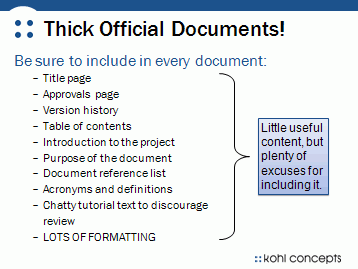Here is the slide deck: Secrets of Faking a Test Project. This is satire, but it is intended to get your attention and help you think about whether you are creating value on your projects, or merely faking it by following convention.
The Back Story
Back in 2007 I got a request to fill in for James Bach at a conference. He had an emergency to attend to and the organizers wondered if I could take his place. One of the requests was that I present James’ “Guide to Faking a Test Project” presentation because it was thought-provoking and entertaining. They sent me the slide deck and I found myself chuckling, but also feeling a bit sad about how common many of the practices are.
I couldn’t just use James’ slides because he has an inimitable style, and I had plenty of my own ideas and experiences to draw on that I wanted to share, so I used James’ slide deck as a guide and created and presented my own version.
This presentation is satirical – we challenge people to think about how they would approach a project where the goal is to release bad software, but you make it look as if you really tried to test it well. It didn’t take much effort on our part, we just looked to typical, all too common practices that are often the staple of how people approach testing projects, and presented them from a different angle.
I decided to release these slides publicly today, because almost 5 years after I first gave that presentation, this type of thing still goes on. Testers are forced into a wasteful, strict process of testing that rarely creates value. One of my colleages contacted me – she is on her first software testing project. She kept asking me about different practices that to her seemed completely counter-productive to effective testing, and asked if it was normal. Much of what she has described about her experiences are straight out of that slide deck. In this case, I think it is a naive approach. No doubt managers are much more worried about meeting impossible deadlines than finding problems that might take more time than is allocated, rather than blatant charlatans who are deliberately faking it, but sadly, the outcome is the same.
If you haven’t thought about how accepted testing approaches and “best practices” can be viewed from another perspective, I hope this is an eye opener for you. While you might not think it is particularly harmful to a project to merely follow convention, you might be faking testing to the most important stakeholder: you.
